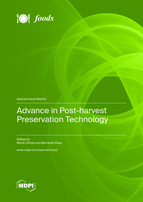Advance in Post-harvest Preservation Technology
A special issue of Foods (ISSN 2304-8158). This special issue belongs to the section "Food Packaging and Preservation".
Deadline for manuscript submissions: closed (5 November 2022) | Viewed by 55893
Special Issue Editors
Interests: quality of fresh and fresh cut fruits and vegetables; innovative pre-treatment; packaging and/or storage condition; modified and controlled atmosphere; logistic cold chain; innovative transport system; no-destructive systems for quality evaluation
Special Issues, Collections and Topics in MDPI journals
Interests: fresh fruit and vegetables; minimally processed product; postharvest physiology; storage condition; chemical and physical treatment; modified and controlled atmosphere; active packaging; non-destructive quality evaluation; logistic solutions; nutritional and sensorial evaluation of fruit and vegetables; volatile compounds as quality markers
Special Issues, Collections and Topics in MDPI journals
Special Issue Information
Dear Colleagues,
Fruits and vegetables are important sources of nutrients such as vitamins, minerals, and bioactive compounds, which provide many health benefits. However, due to non optimal postharvest management, large quantities of fresh or fresh-cut fruit and vegetables loss their quality and nutritional valuees before they reach the consumer.
This special issue covers technologies in harvesting, handling, and storage of vegetables, including storage strategies (active packaging, edible coatings, application of nanotechnology in the postharvest technology of vegetable crops, and more) aimed to improve the shelf-life of fresh and fresh-cut fruits and vegetable.
Dr. Maria Cefola
Dr. Bernardo Pace
Guest Editors
Manuscript Submission Information
Manuscripts should be submitted online at www.mdpi.com by registering and logging in to this website. Once you are registered, click here to go to the submission form. Manuscripts can be submitted until the deadline. All submissions that pass pre-check are peer-reviewed. Accepted papers will be published continuously in the journal (as soon as accepted) and will be listed together on the special issue website. Research articles, review articles as well as short communications are invited. For planned papers, a title and short abstract (about 100 words) can be sent to the Editorial Office for announcement on this website.
Submitted manuscripts should not have been published previously, nor be under consideration for publication elsewhere (except conference proceedings papers). All manuscripts are thoroughly refereed through a single-blind peer-review process. A guide for authors and other relevant information for submission of manuscripts is available on the Instructions for Authors page. Foods is an international peer-reviewed open access semimonthly journal published by MDPI.
Please visit the Instructions for Authors page before submitting a manuscript. The Article Processing Charge (APC) for publication in this open access journal is 2900 CHF (Swiss Francs). Submitted papers should be well formatted and use good English. Authors may use MDPI's English editing service prior to publication or during author revisions.
Keywords
- physical and chemical pretreatment
- storage technology
- innovative packaging
- active packaging
- controlled atmosphere
- modified atmosphere
- nano sensors
- edible coating
- cold plasma








